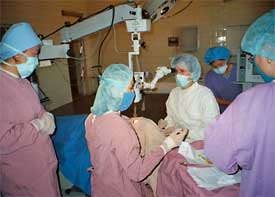
This web page is part of the Michigan Today Archive. To see this story in its original context, click here.
Physicians saving sight in MongoliaBy Laurel Thomas GnageyWhen two physicians from the Kellogg Eye Center returned from Mongolia in September, they left behind five digital cameras, a laptop computer and a number of people who were spared a life of blindness.
Drs. Susan Thoms and Theresa Nairus—both physicians in Kellogg's Livonia satellite office—along with three other eye specialists from the United States and Canada, went to the country to set up the CYBER-SIGHT program through ORBIS, an international organization that seeks to end preventable blindness in Third-World countries by the year 2020. The team also went to train Mongolian physicians and health care professionals in the diagnosis and treatment of eye problems, while caring for several patients as they taught. ORBIS estimates that 45 million people in the world are blind, and 135 million have low vision and are at risk of blindness. The organization's Web site says with proper care and treatment, 80 percent of those in the latter group would not have to lose their sight. In its effort to end avoidable blindness, ORBIS connects ophthalmologists around the world with those in the United States who have more advanced training in the diagnosis of eye disease. In general, physicians in Third-World countries don't have the same level of training as those in the United States, says Nairus, clinical instructor of comprehensive ophthalmology and cornea, external diseases, and refractive surgery, who, in addition to serving in Livonia, also practices at the Veterans Administration Hospital in Ann Arbor and at the Kellogg Milford office. "They have no college education prior to attending medical school, and they study ophthalmology only for one year," she says. "They basically cut off three or four years of their training." The computer equipment the team left will be used by local health care professionals who treat eye disease and injury. Through CYBER-SIGHT, physicians in Mongolia and the nearly two dozen other countries that now have the program can take a photo of a patient's eye, send it and their questions to a Web site, and hear back from a participating physician within 48 hours. Thoms, who is a clinical assistant professor of ophthalmology and visual science, serves as a mentor for physicians who need her expertise in the diagnosis and treatment of cataracts. She says traveling to Mongolia allowed her to see what resources physicians there have available, which is important when serving as a mentor through "You have to answer them in the framework of what their capabilities are," she says. In Mongolia they have limited equipment and expired anesthesia drugs that sometimes work and sometimes do not, and they reuse many items that we would not in this country, she says. "But they do well with the resources they have," Thoms says. "They're trying, and they're eager to learn." One thing they do not have yet is a donor bank for transplants, says Nairus, a cornea specialist at Kellogg. She had to take along three corneas donated by the Eye Bank Association of America so she could train physicians to perform a transplant. Of the 60 patients she saw during the three days, 30 were candidates for a cornea transplant. "I had to be pretty picky about who could get the most use out of the cornea for the longest time," she says of the difficult process of choosing recipients. "I had one 16-year-old boy who showed up three days in a row, in a suit, hoping to be picked." He was not a good candidate because he lived too far away to receive the follow-up care a transplant would require. "The sad thing is that if 30 people walked in here [Kellogg] today, they all would get a transplant." One group she had to rule out was nomadic cattle breeders who make up 30 percent of the population. Because they roam around the desert, these Mongolians are susceptible to a disease called climactic droplet keratopathy, which is caused by damage from ultraviolet light exposure. Returning to that lifestyle after a transplant most likely would mean failure of the new cornea, Nairus says. Of the three people chosen, one had waited seven years, one 12 and the other 20. If she goes back again in the future, Nairus hopes the Mongolian physicians will have established a donor bank, which she was helping them begin to organize before she left. Out of the 55 patients Thoms saw, 15 represented the best teaching cases and were chosen for surgery. This trip to Mongolia was her second. She went in 1997 through another organization. "I wanted to see what had happened in seven years and if anything had changed," she says. Many of the facilities had been updated, but the need for help and expertise had not, she says. The 2.6 million citizens of the country, which is twice the geographic size of Texas, had not changed much either. "It's a very grateful group of people," she says. "It's a very interesting place with friendly, hospitable people. I'd like to go back in a few years. |
|
Michigan Today News-e is a monthly electronic publication for alumni
and friends. |
| MToday NewsE | |
|
|
Michigan Today
online alumni magazine
University Record
faculty & staff newspaper
MGoBlue
athletics
News Service
U-M news
Photo Services
U-M photography
University of Michigan
gateway
|
• Maps |


